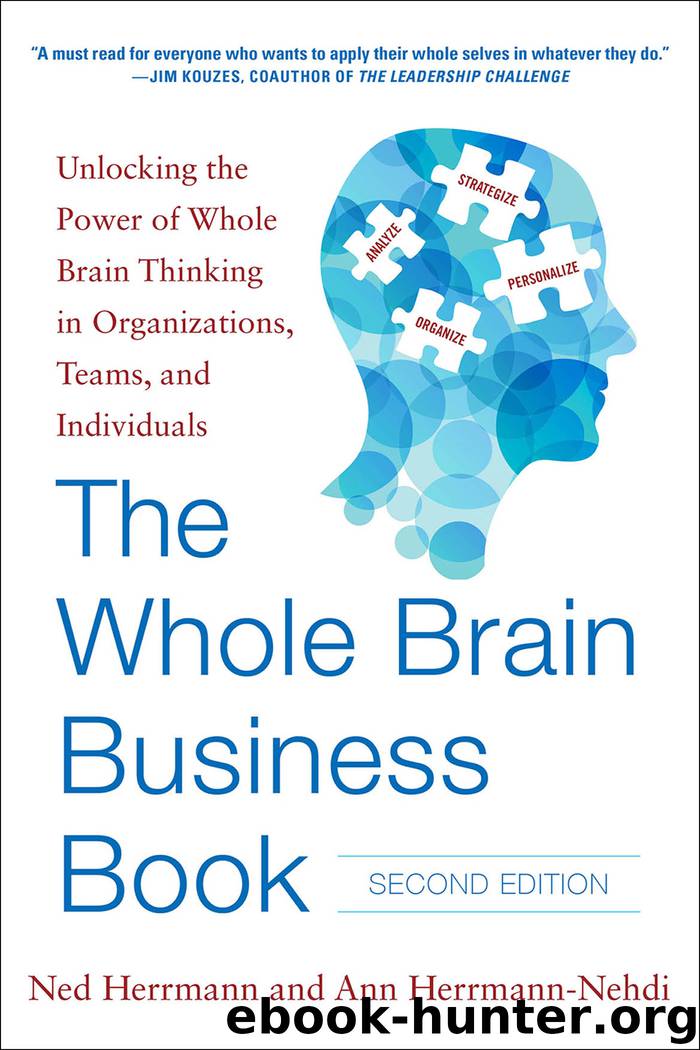The Whole Brain Business Book by Ned Herrmann

Author:Ned Herrmann
Language: eng
Format: epub
Publisher: McGraw-Hill Education
Published: 2015-02-24T16:00:00+00:00
The Whole Brain approach provides a consistent method for diagnosing the mentality of each of these documents or statements, allowing for a clear comparative analysis. For example, Figure 15-3 shows an array of what I refer to as the key leadership issues of a large U.S. corporation.
FIGURE 15-3 Key leadership HBDI Text Profiles for a U.S. corporation. Pro-forma profiles of key leadership issues.
These HBDI pro-forma profiles were developed by creating an HBDI Text Profile of each descriptive word, sentence, paragraph, or page of a particular document. Also included in the analysis were any charts, graphs, financial data, or illustrations. For example, a page of financial data would be diagnosed as an exclusively A-quadrant element of the complete document. An illustration of a family enjoying a picnic, in which the company’s products were displayed, would be considered primarily a C-quadrant element, with perhaps a D-quadrant contribution if the products were being newly introduced. In contrast, a page devoted to the manufacturing assembly line operation and its production results would contribute a strong B-quadrant element to the overall diagnosis. In this way, the thinking preference characteristics of the statements and documents are diagnosed and aggregated into an overall profile of that key leadership issue.
Even to the untutored eye, it is clear that the key leadership issues as depicted by the profiles shown in Figure 15-3 are reasonably consistent in the rational and analytic A quadrant, less consistent in the organized, structured B quadrant, and even less consistent in the conceptual, visionary D quadrant. They are flagrantly inconsistent in the humanistic, interpersonal C quadrant. This lack of alignment lessens the credibility of the leaders unless they can model what is being expressed. In this case the profiles validated a situation in which management was proclaiming values that were not actually being carried out. It described things to the investing public that were not experienced by the customers and employees, and the good intentions embedded in the vision statement were more of a pipe dream than a reality.
I find it extremely revealing that, in the vast majority of cases, it is the C or D quadrant that is consistently out of alignment with actual behaviors. This is where the rubber tire of leadership credibility meets the hard pavement of employee reality. The documents and statements that leaders create invite people to compare their intentions with their performance, and there are consequences when the described behaviors aren’t in sync with reality.
Download
This site does not store any files on its server. We only index and link to content provided by other sites. Please contact the content providers to delete copyright contents if any and email us, we'll remove relevant links or contents immediately.
| Ethics | Etiquette |
| Fashion & Image | Health & Stress |
| Motivation & Self-Improvement | Work Life Balance |
| Workplace Culture |
Tools of Titans by Timothy Ferriss(8304)
Change Your Questions, Change Your Life by Marilee Adams(7684)
Deep Work by Cal Newport(6966)
Playing to Win_ How Strategy Really Works by A.G. Lafley & Roger L. Martin(6083)
Man-made Catastrophes and Risk Information Concealment by Dmitry Chernov & Didier Sornette(5956)
Digital Minimalism by Cal Newport;(5704)
Big Magic: Creative Living Beyond Fear by Elizabeth Gilbert(5677)
The Slight Edge by Jeff Olson(5376)
Ego Is the Enemy by Ryan Holiday(5347)
The Motivation Myth by Jeff Haden(5175)
The Laws of Human Nature by Robert Greene(5080)
Stone's Rules by Roger Stone(5052)
Tuesdays with Morrie by Mitch Albom(4732)
Eat That Frog! by Brian Tracy(4483)
Rising Strong by Brene Brown(4411)
Skin in the Game by Nassim Nicholas Taleb(4203)
Bullshit Jobs by David Graeber(4140)
The Money Culture by Michael Lewis(4134)
Skin in the Game: Hidden Asymmetries in Daily Life by Nassim Nicholas Taleb(3961)
